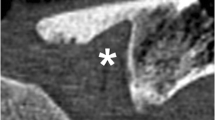Abstract
Thin-slice computed tomography provides the imaging modality of choice in analysing the ossification process of the medial clavicular epiphysis for the purpose of forensic age diagnostics in the living in the course of criminal proceedings. The classification of the ossification stages by Schmeling et al. compass the emergence of an epiphyseal ossification centre (stage 2), the partial fusion of the epiphysis with the metaphysis (stage 3), the complete fusion of these osseous elements including a visible epiphyseal scar (stage 4), and the complete fusion without a visible epiphyseal scar (stage 5). In the present study, each of the ossification stages 2 and 3 was divided into an early, intermediate and late phase. The authors evaluated the thin-slice CT scans of 185 patients aged between 13 and 26 years. In all these cases, a stage 2 or 3 had been determined in a previous study. The late stage 3, which is characterized by a fusion between metaphysis and epiphysis completing more than two thirds of the former epiphyseal gap, first appeared at age 19 in both sexes. If a late stage 3 is found, it is therefore possible to substantiate that an individual has already reached the legally important age threshold of 18 years.

Similar content being viewed by others
References
Cruz-Landeira A, Linares-Argote J, Martínez-Rodríguez M, Rodríguez-Calvo MS, Otero XL, Concheiro L (2009) Dental age estimation in Spanish and Venezuelan children. Comparison of Demirjian and Chaillet's scores. Int J Legal Med. doi:10.1007/s00414-009-0380-5
Knell B, Ruhstaller P, Prieels F, Schmeling A (2009) Dental age diagnostics by means of radiographical evaluation of the growth stages of lower wisdom teeth. Int J Legal Med 123:465–469
Landa MI, Garamendi PM, Botella MC, Alemán I (2009) Application of the method of Kvaal et al. to digital orthopantomograms. Int J Legal Med 123:123–128
Olze A, Solheim T, Schulz R, Kupfer M, Schmeling A (2009) Evaluation of the radiographic visibility of the root pulp in the lower third molars for the purpose of forensic age estimation in living individuals. Int J Legal Med (accepted)
Thevissen PW, Fieuws S, Willems G (2009) Human dental age estimation using third molar developmental stages: does a Bayesian approach outperform regression models to discriminate between juveniles and adults? Int J Legal Med 124:35–42
Zeng DL, Wu ZL, Cui MY (2009) Chronological age estimation of third molar mineralization of Han in southern China. Int J Legal Med. doi:10.1007/s00414-009-0379-y
Dünkel F, Kalmthout A van, Schüler-Springorum H (1997) Entwicklungstendenzen und Reformstrategien im Jugendstrafrecht im europäischen Vergleich. Forum, Mönchengladbach
Schmeling A, Grundmann C, Fuhrmann A, Kaatsch H-J, Knell B, Ramsthaler F, Reisinger W, Riepert T, Ritz-Timme S, Rösing FW, Rötzscher K, Geserick G (2008) Criteria for age estimation in living individuals. Int J Legal Med 122:457–460
Kreitner K-F, Schweden F, Schild HH, Riepert T, Nafe B (1997) Die computertomographisch bestimmte Ausreifung der medialen Klavikulaepiphyse—Eine additive Methode zur Altersbestimmung im Adoleszentenalter und in der dritten Lebensdekade? Fortschr Röntgenstr 166:481–486
Kreitner K-F, Schweden FJ, Riepert T, Nafe B, Thelen M (1998) Bone age determination based on the study of the medial extremity of the clavicle. Eur Radiol 8:1116–1122
Schulz R, Mühler M, Mutze S, Schmidt S, Reisinger W, Schmeling A (2005) Studies on the time frame for ossification of the medial epiphysis of the clavicle as revealed by CT scans. Int J Legal Med 119:142–145
Mühler M, Schulz R, Schmidt S, Schmeling A, Reisinger W (2006) The influence of slice thickness on assessment of clavicle ossification in forensic age diagnostics. Int J Legal Med 120:15–17
Schulz R, Mühler M, Reisinger W, Schmidt S, Schmeling A (2008) Radiographic staging of ossification of the medial clavicular epiphysis. Int J Legal Med 122:55–58
Schulz R, Zwiesigk P, Schiborr M, Schmidt S, Schmeling A (2008) Ultrasound studies on the time course of clavicular ossification. Int J Legal Med 122:163–167
Kellinghaus M, Schulz R, Vieth V, Schmidt S, Schmeling A (2009) Forensic age estimation in living subjects based on the ossification status of the medial clavicular epiphysis as revealed by thin-slice computed tomography. Int J Legal Med. doi:10.1007/s00414-009-0398-8
Schmeling A, Schulz R, Reisinger W, Mühler M, Wernecke K-D, Geserick G (2004) Studies on the time frame for ossification of medial clavicular epiphyseal cartilage in conventional radiography. Int J Legal Med 118:5–8
Mincer HH, Harris EF, Berryman HE (1993) The A.B.F.O. study of third molar development and its use as an estimator of chronological age. J Forensic Sci 38:379–390
Gunst K, Mesotten K, Carbonez A, Willems G (2003) Third molar root development in relation to chronological age: a large sample sized retrospective study. Forensic Sci Int 136:52–57
Schmeling A, Baumann U, Schmidt S, Wernecke KD, Reisinger W (2006) Reference data for the Thiemann-Nitz method of assessing skeletal age for the purpose of forensic age estimation. Int J Legal Med 120:1–4
Schmidt S, Mühler M, Schmeling A, Reisinger W, Schulz R (2007) Magnetic resonance imaging of the clavicular ossification. Int J Legal Med 121:321–324
Quirmbach F, Ramsthaler F, Verhoff MA (2009) Evaluation of the ossification of the medial clavicular epiphysis with a digital ultrasonic system to determine the age threshold of 21 years. Int J Legal Med 123:241–245
Schulze D, Rother U, Fuhrmann A, Richel S, Faulmann G, Heiland M (2006) Correlation of age and ossification of the medial clavicular epiphysis using computed tomography. Forensic Sci Int 158:184–189
Schmeling A, Reisinger W, Loreck D, Vendura K, Markus W, Geserick G (2000) Effects of ethnicity on skeletal maturation—consequences for forensic age estimations. Int J Legal Med 113:253–258
Acknowledgment
The authors would like to thank Prof. Dr. Walter Reisinger, Institute of Clinical Radiology at the Charité–Universitätsmedizin Berlin, for suggesting this study.
Author information
Authors and Affiliations
Corresponding author
Rights and permissions
About this article
Cite this article
Kellinghaus, M., Schulz, R., Vieth, V. et al. Enhanced possibilities to make statements on the ossification status of the medial clavicular epiphysis using an amplified staging scheme in evaluating thin-slice CT scans. Int J Legal Med 124, 321–325 (2010). https://doi.org/10.1007/s00414-010-0448-2
Received:
Accepted:
Published:
Issue Date:
DOI: https://doi.org/10.1007/s00414-010-0448-2




